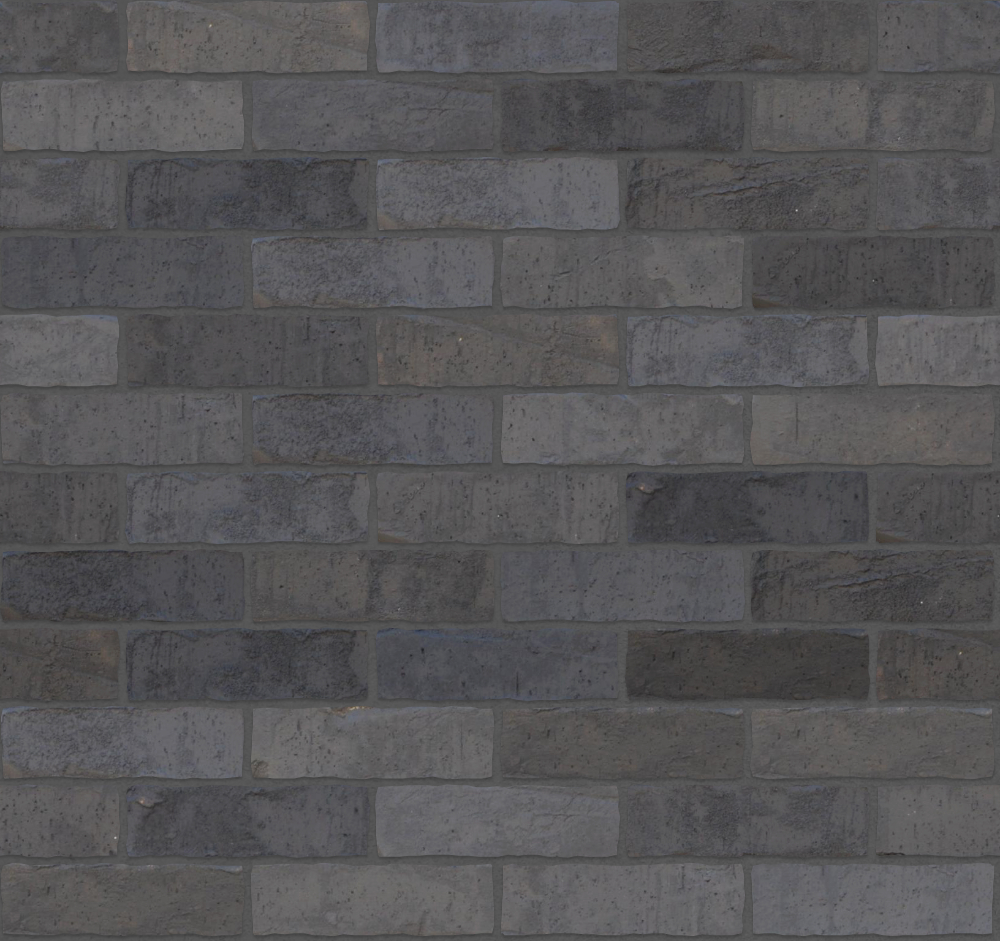Painted Brick Stretcher
Category
Brick
Download
Edit
A dark, sombre shade of paint on a riven, sand faced brick finish reminiscent of engineering brick or dark natural stone finishes such as slate, basalt or black granite. Sand facing involves spraying sand onto the brick before it is fired, resulting in small ridges and shelves, creating a semi-rough, uneven, random texture much like a natural rock face, waves or cloud formations. Deep blues, greys, silvers and blacks are found throughout this brick texture, with some shades of red-brown hinting at the original colour of the base clay brick. The sand creased surface finish is more pronounced due to the relief of the paint, augmenting the depth of the surface by enhancing the shadows and highlights, creating a variegated, random surface texture and finished colour.
Painting brick is a more cost effective but less efficient method of colouring brick than using pigments and different compositions of raw materials pre-firing, as it requires re-painting after a certain period to maintain the surface colour, whereas pigmented brick is consistent in colour throughout the material as the colouring is added to the brick mixture itself, meaning the brick maintains a consistent surface colour even if the surface is damaged. Painting after firing or installation can be undertaken to cover cracks, irregularities or sub-standard bricks; on low-budget renovation projects where a new colour is desired without completely replacing the brickwork; to match the colour of existing bricks in restoration projects where it is difficult to replicate the exact chemical or pigment during the manufacturing process; to maintain consistency of colour between batches of bricks on large projects, or to paint over repair work carried out on blemishes in the underlying masonry.
Bricks are one of the most common materials in architecture and construction. With recorded uses dating back over 9000 years, brick traces its origins to mud and straw adobe blocks as found in Africa, southern Asian and southern American regions where hot, dry climates quickly dried and cured the earth bricks naturally in the heat. Clay bricks were used extensively throughout the Roman Empire thanks to the Romans’ invention of the mobile kiln, an innovation on the kiln used by ancient Egyptian builders to fire clay mixtures when placed in moulds, which enabled brick manufacture across Rome’s territories, using an increased range of local clay and soil compositions. Bricks were then regularly used in Europe from around the 12th century, when northern European countries traded materials, knowledge and design ideologies with Italy during the Gothic and Renaissance eras, spreading the use of Roman designs and construction methods, until dying out for a period due to bricks’ inability to recreate the intricate shapes of ornament and decoration associated with these styles.
The exploration of new forms and manufacturing methods seen a return to popularity, combined with their increasingly popular reputation as a replacement to timber in densely populated cities in the 17th century, particularly London, due to their far superior fire retarding properties, following a spate of particularly serious, destructive urban fires that ripped through older timber building stock. Other cities followed suit during the 18th century industrial revolution as bricks proved a hardy, enduring, cost effective, simple to construct, reliable, impervious, consistently dimensioned building unit protecting against damp air and wet ground conditions, especially after the invention of fast, mass manufacturing techniques. Brick was then popularised in northern America and other English, Belgian, Dutch, French, Spanish and Portuguese territories, through early émigrés taking their masonry skills abroad.
They remain popular due to their readily available raw materials, simple manufacture, low cost, ease of maintenance, basic-skilled assembly and attractive variety of colours, textures and finishes. Modern brick can be cut to standard sizes to form a versatile, durable building product, or specially manufactured to suit a variety of angles, curves and unique shapes for decorative purposes on organic forms. Hard-wearing and with excellent structural and thermal properties, they are a popular, efficient, human-scaled material for paving, load-bearing walls, cladding systems, landscaping and interior decorative walls, while a variety of finishes and palettes within the one product can create rustic, weathered, industrial aesthetics increasingly popular in bespoke, contemporary domestic, hospitality and workplace environments; practical, perfunctory settings; or decorative façades. Preferred for their domestic, human scale, bricks are one of the easiest construction materials to handle and build with when combined and laid with cementitious mortars. They are well suited to domestic, care, primary education and community building types in all climatic settings provided they are manufactured correctly and to the right specifications with respect to their locale.
The dark geological colour palette and surface patterns on this painted brick are restrained, quiet and cool, creating a brick texture which would be an excellent pairing for relating to impressive features in the natural landscape such as rock formations or mountains, or in close proximity to dark, cold bodies of water. It can also be used as a cool, grey-blue base colour to emphasise a stark contrast between lighter, softer materials and colours such as timber, metals or glass, or more visually active and bold colours; in modern minimalist designs to create a sleek, sharp aesthetic; or to create grounded, subdued, contemplative, thoughtful, humane spaces.
A seamless brick texture with painted brick arranged in a stretcher pattern. Seamless textures can be tiled repeatedly across a surface without visible seams making them useful for architectural drawings and 3D models. This image can be used as a SketchUp texture, Revit material or imported into Photoshop for use in 2D illustrations. A high resolution version of this texture is available, as well as CAD hatches and PBR maps with Architextures Pro.

